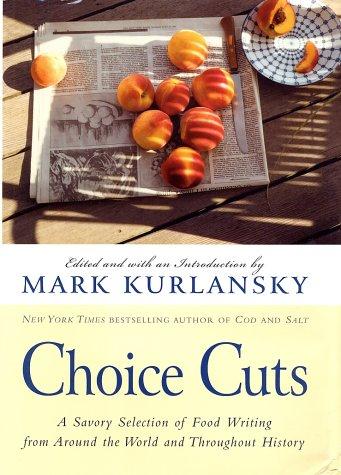Mark Kurlansky’s Choice Cuts: A Savory Selection of Food Writing from Around the World and Throughout History, published in 2002, isn’t just another cookbook; it’s a culinary journey through time and cultures, a vibrant anthology that demonstrates how deeply food is intertwined with human history. Kurlansky, known for his meticulous research and engaging narratives in works like Cod and Salt, brings his characteristic passion to this collection, curating a diverse range of voices that explore the cultural significance of food across different eras. This book is more than just recipes or menus; it’s about understanding how food shapes our identities and our world. This book still resonates today because it reminds us that even something as common as eating is a rich tapestry of human experience.
Kurlansky’s selection showcases a broad spectrum of writing about food, from ancient Babylonian recipes to modern-day food journalism. The anthology is organized thematically, allowing readers to explore concepts like regional cuisine, the social role of meals, and the art of cooking. Rather than a chronological approach, this thematic structure creates a sense of flow, connecting seemingly disparate cultures and time periods through the shared human experience of food. The book’s target audience includes anyone interested in food history, culinary anthropology, or simply good writing. Its accessible prose style avoids academic jargon, making it enjoyable for both casual readers and culinary enthusiasts. The inclusion of diverse perspectives – from famous chefs to anonymous cookbook authors – adds to its rich tapestry. Click here to purchase this book.
One of the great strengths of Choice Cuts is the way it uses food as a lens to examine social and political issues. For example, the selected writings on medieval feasts aren’t just descriptions of lavish banquets; they also reveal power dynamics and social hierarchies within those societies. Similarly, pieces exploring the impact of colonialism on indigenous food cultures demonstrate how food can be used as a tool for both oppression and cultural preservation. The book isn’t just about the pleasure of eating; it’s about the complex ways in which food is embedded in our social fabric. It highlights how what we eat and how we eat is rarely ever simply about nourishment.
The anthology is packed with practical insights, though it’s not a cookbook in the traditional sense. Rather, it’s a lesson in how to think about food – how to appreciate the origins of ingredients, the cultural practices surrounding their preparation, and the social context of a meal. Kurlansky’s selections demonstrate the importance of understanding the history of what we eat, encouraging readers to become more thoughtful consumers and cooks. The book’s diverse selections allow for cross-cultural comparisons and can inspire readers to experiment with flavors and ingredients from around the world. I found the sections focusing on regional variations particularly insightful, demonstrating the rich diversity within even specific cuisines, like the subtle differences between Italian pasta from various regions.
Kurlansky’s expertise shines through in his careful curation and introductory notes for each piece. His background as a journalist and food historian gives him a unique perspective on the selected works, adding context and significance to each entry. He doesn’t just present these writings passively; he engages with them, providing insightful commentary that enhances the reader’s understanding. The source materials are varied, ranging from classic cookbooks to historical documents to personal essays. Kurlansky’s choices underscore the idea that food writing isn’t a recent phenomenon; it has existed in many forms throughout history. His careful research brings credibility to this diverse collection. Discover this fascinating read here.
The writing style throughout the anthology is as diverse as the cultures represented. Some pieces are straightforward recipes, while others are descriptive narratives or philosophical musings on the meaning of food. Kurlansky’s own prose is clear and concise, making even the most complex ideas accessible. The pacing of the book is well-managed, with shorter pieces interspersed among longer essays, keeping the reader engaged. It never feels like a dry textbook; it reads more like a fascinating conversation about the human experience through food. I found myself captivated by the diversity of voices and the different approaches to food writing, from the technical to the lyrical.
The book left me with a deeper appreciation for the cultural significance of food. It has influenced my own approach to cooking and eating, prompting me to consider not just the taste of food, but also its history and its social context. It made me realize that every dish tells a story, and that understanding these stories can enrich our lives in profound ways. This personal connection was especially powerful because it moved my focus from simply consuming to actively engaging with my food. You can delve deeper into this topic through this link.
Choice Cuts is a significant contribution to the literature on food. It demonstrates that food is more than just sustenance; it’s a powerful cultural force that shapes our identities, our societies, and our history. The book’s lasting impact lies in its ability to make us more mindful and thoughtful eaters. It shows how food can be a window into the past and a means of understanding the present. It is more than just a collection of writings; it is a celebration of the human connection to food. I would recommend this book to anyone with an interest in food, history, culture, or simply good writing. It is a book that can be revisited again and again, with new insights to be discovered each time. For readers who enjoy this book, they might also appreciate works like The Food Explorer by Daniel Stone or Consider the Fork by Bee Wilson, which similarly explore the history and cultural significance of food. Purchase your copy today.

